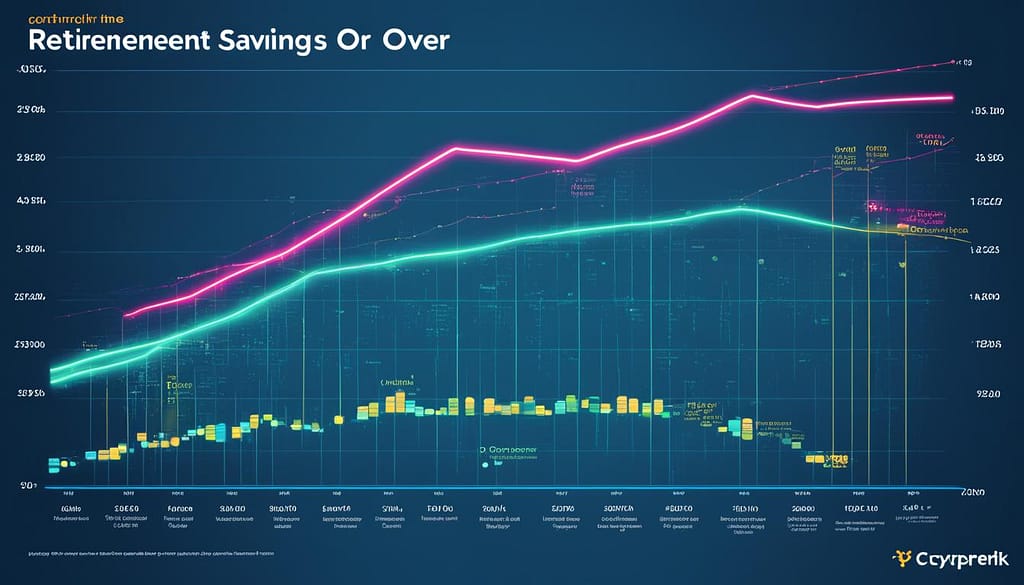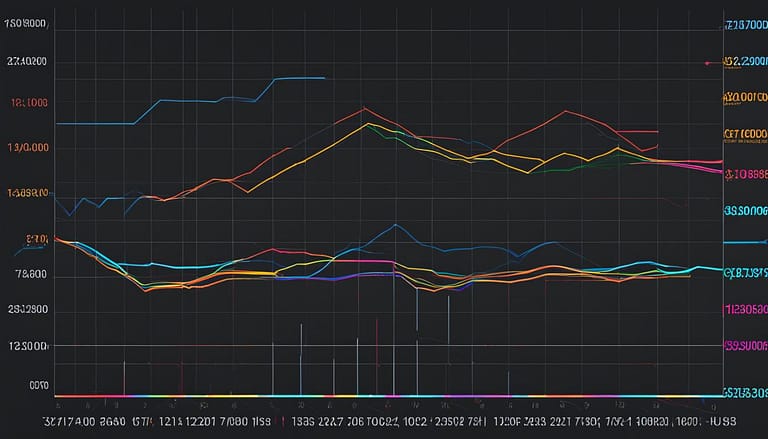Cryptocurrency and Your Financial Future: A Planning Guide
Amid the rapidly evolving financial markets, Canadians are increasingly turning attention to Cryptocurrency Financial Planning, seeking to diversify their portfolios and safeguard their futures. Crypto Investments have emerged as a pivotal element of Financial Planning in Canada, offering not just an alternative, but a proactive approach to building wealth in the digital era. With assets such as Bitcoin and Ethereum transforming the investment landscape, understanding their role in retirement planning has never been more critical.
Key Takeaways
- Cryptoassets are becoming a vital part of modern financial strategies.
- Investors are progressively factoring inflation and healthcare costs into their retirement plans with cryptocurrency.
- It is crucial to aim for wealth building with cryptocurrencies through a long-term lens, recognizing their volatility and potential for growth.
- In Canada, integrating crypto in financial planning demands a diversified portfolio to balance potential risks and returns.
- Financial institutions are increasingly supporting cryptocurrencies as part of retirement planning.
- Educating oneself on the complexities of cryptocurrency is important for strategic investment.
Embracing the Digital Age: The Evolution of Retirement Planning
As the digital landscape reshapes the global economy, Retirement Planning in Canada is transitioning into an era where Digital Assets stand as pivotal components of a secure future. This transformative phase endorses investment diversification with cryptocurrencies being increasingly integrated into financial portfolios, challenging the traditions of saving.
Traditional Retirement vs. Crypto-Inclusive Portfolios
The Canadian investment scenery is evolving; where once the hallmarks of pension security were found in the stability of pension plans and Individual Retirement Accounts (IRAs), we are now observing a dynamic shift towards including cryptocurrencies as a part of Investment Diversification strategies. This digital embracement enables investors to navigate through the unpredictability of economic climates.
The Age of Cryptocurrency: A Paradigm Shift in Financial Strategy
Cryptocurrency is no longer at the fringes of finance but is quickly becoming central to Retirement Planning conversations. Firms like Fidelity Investments are spearheading this mainstream adoption by featuring Bitcoin in their retirement solutions, signifying a remarkable shift in how Canadians prepare for their later years. The merit of this inclusion lies in the blockchain foundation of digital currencies and their unprecedented appreciation potential, stipulating a reimagined blueprint for long-term savings.
| Retirement Asset Type | Traditional Approach | Crypto-Inclusive Approach |
|---|---|---|
| Investment Stability | High – Pegged to steady-performing funds | Moderate – Subject to market volatility |
| Inflation Protection | Low – Often eroded by inflation rates | High – Potential hedge against inflation |
| Diversification Level | Moderate – Limited to conventional assets | High – Expands to include digital currencies |
| Long-Term Appreciation | Moderate – Consistent yet capped growth | High – High upside potential, albeit with risks |
Through the integration of cryptocurrencies, the very fabric of fiscal strategy for retirement is undergoing a significant overhaul, positioning Canadian investors at the forefront of the nexus between traditional finance and its digitized future.
Understanding the Fundamentals of Cryptocurrency
Embarking on the path of cryptocurrency investment requires a solid grasp of Cryptocurrency Basics, the intricacies of Blockchain, and the ever-evolving landscape of Digital Currency. Let’s delve into the core concepts that will equip you with the knowledge to navigate this digital terrain.
Blockchain Technology: The Backbone of Digital Currency
Blockchain is undoubtedly the bedrock of the cryptocurrency world. This advanced technology serves as the decentralized and transparent ledger that meticulously records every transaction. Its incorruptible digital architecture ensures consistent monitoring and verification by a vast network of computers, which makes it an infallible cornerstone of any digital currency.
Deciphering the Cryptic: How Cryptocurrency Works
Cryptocurrencies, such as Bitcoin and Ethereum, are best understood as digital or virtual coins secured by cryptographic technologies, allowing for secure, peer-to-peer transactions. These digital assets offer tantalizing high-return potential but also bring inherent risks, being susceptible to the volatility of the markets. The unregulated nature of the cryptocurrency market presents a fresh set of challenges, while its independence from central bank controls implies a reduced risk of traditional financial systems’ interference.
It’s these dimensions of cryptocurrency—the decentralized means of transactions, the high-risk/high-reward dynamic, and the peer-to-peer framework—that make understanding the fundamentals non-negotiable for anyone looking to consider cryptocurrencies as part of their financial repertoire.
Cryptocurrency Financial Planning: Securing Your Retirement
Financial stability and meeting Long-Term Financial Goals are cornerstones of a prosperous retirement, and Crypto Retirement Planning offers an innovative pathway toward achieving this end. The integration of cryptocurrencies into retirement portfolios has been gaining traction, urging investors to consider a blend of traditional and digital assets to construct a future-proofed financial strategy.
To navigate through the complexities of cryptocurrency as part of one’s retirement planning, there are several key elements to consider:
- Establishing a clear understanding of your investment timeline and how it aligns with the volatile nature of digital assets.
- The need for a diversified investment strategy to minimize risks and leverage the growth potential of cryptocurrencies.
- Assessing your risk appetite and ensuring that the chosen crypto investments fit within your comfort zone.
Given the intricate nature of crypto markets, retirees are encouraged to seek a balance between the high-reward potential of digital currencies and traditional, more stable investment classes. Prudence dictates that for long-term sustainability, crypto assets should form part of a broader investment tapestry.
| Investment Type | Risk Level | Potential Returns | Suitability for Retirement Planning |
|---|---|---|---|
| Traditional (Bonds, Stocks) | Low to Moderate | Steady | High |
| Cryptocurrency | High | Highly Variable | Medium to High, with cautious strategy |
| Real Estate | Low to High | Can be significant, dependent on market | High |
| Commodities | Medium to High | Subject to market fluctuations | Medium |
“The goal of retirement is to live off your assets—not on them.” – Frank Eberhart
Careful contemplation of these aspects underlines the fact that cryptocurrency should not be seen as a solitary vehicle for retirement savings but as one part of an asset mix tailored to enhance financial durability and independence during one’s golden years.
Navigating the Risks and Rewards of Crypto Investments
Investing in the ever-evolving world of cryptocurrencies embodies a journey through a landscape rife with high stakes and high rewards. The road traveled by a crypto investor is one punctuated by peaks of lucrative gains and valleys of sobering losses. With the goal of harnessing the transformative power of blockchain technology, investors operate within a realm where Crypto Market Volatility is as much a source of opportunity as it is of Investment Risks.
Volatility: The Double-Edged Sword in Crypto Investing
The swift tides of the Crypto Market Volatility terrify as much as they tantalize. Digital currencies have carved out a niche in the financial world, where breathtaking ascents and steep descents in market value happen at a moment’s notice. Investors eager for rapid gains must equally brace for the prospect that the value of their digital assets could plunge, reflecting the dual nature of this volatile space.
Regulatory Considerations and Keeping Up with Compliance
When traversing the dynamic terrain of crypto investments, the specter of evolving Cryptocurrency Regulation looms large. The absence of a universal regulatory framework complicates the investment process, injecting a layer of uncertainty. Yet, it also galvanizes investors towards vigilance and proactive learning – to stay ahead of legislative shifts and ensure their investments adhere to the latest compliance standards.
| Crypto Volatility Indicator | Potential Impact on Investment | Regulatory Aspect to Consider |
|---|---|---|
| Market Sentiment | Can drastically amplify or suppress asset price | Impact of global news on local regulations |
| Liquidity | Affects the ease of trading and price stability | Legal restrictions on crypto exchanges and OTC platforms |
| Technological Developments | Upgrade or flaws in blockchain tech can lead to volatility | Compliance with technological standards and cybersecurity laws |
| Economic Events | Global financial shifts may resonate within the crypto market | Macroeconomic policies and their influence on crypto |
Strategizing Your Investment: Crypto for the Long Term
Investing in cryptocurrency is not merely about riding the wave of the latest financial trend; it’s about meticulously crafting an Investment Strategy that stands the test of time. Your approach to Crypto Asset Allocation must be grounded in a deep understanding of your financial goals and how they align with the inherent risks and rewards of digital currencies.
Assessing Risk Tolerance and Investment Horizons
Key to your success in crypto investing is an honest assessment of your risk tolerance. Are you the type to weather storms in the market, or does every dip and surge send you into a spiral of concern? Delineate your investment horizon—this long-view approach is crucial when integrating cryptocurrencies into your financial plan. Deciding whether you’re investing for a future that’s five years out, or foresee holding onto your assets for decades, will fundamentally shape your strategy.
Building a Diverse and Resilient Crypto Portfolio
To achieve a well-rounded portfolio, it is essential to blend traditional investments with the dynamic world of cryptocurrencies. Diversity is your friend when it comes to mitigating risk and seeking balanced returns. This is where the savvy of Crypto Asset Allocation comes into play—analyzing the market, staying current with global financial trends, and strategically positioning your assets to withstand market fluxes.
Below, you’ll find a table that illustrates a potential approach to diversifying an investment portfolio balancing both traditional and crypto assets:
| Asset Type | Traditional | Crypto | Percentage of Portfolio |
|---|---|---|---|
| Equities | ✔️ | 40% | |
| Bonds | ✔️ | 20% | |
| Real Estate | ✔️ | 10% | |
| Commodities | ✔️ | 5% | |
| Cash/Cash Equivalents | ✔️ | 5% | |
| Major Cryptocurrencies (e.g., Bitcoin, Ethereum) | ✔️ | 15% | |
| Altcoins | ✔️ | 5% |
Your investment approach should account for the rapid change inherent in the cryptocurrency space. Continual learning and flexibility to adapt your strategy to new information is paramount. Whether implementing stop-loss orders, or regularly rebalancing your portfolio, the goal remains consistent: to create a resilient strategy that maximizes your potential for growth while aligning with your appetite for risk and investment outlook.
The Pros and Cons of Crypto in Retirement Savings
The integration of cryptocurrencies into retirement savings portfolios has been met with both curiosity and caution. Advocates herald the dawn of decentralized finance as a revolutionary force in retirement planning, while skeptics point to the turbulence of the crypto market as a reason for restraint. Here, we delve into the significant benefits and potential pitfalls that come with the inclusion of crypto assets in retirement strategies.
Pros: Discussing Growth and Decentralization Benefits
Investors see the allure in leveraging cryptocurrencies for retirement savings growth due to their formidable appreciation potential. Beyond the prospects for financial growth, the decentralized nature of blockchain-based assets offers autonomy from traditional banking systems, which is seen as an advantage in times of economic flux.
Cons: Addressing Security and Marketplace Uncertainties
While the promises of cryptocurrency are bountiful, the market’s volatility casts a long shadow on its stability as a retirement investment. Additionally, the crypto environment is fraught with security concerns, not to mention the uncertainty looming around its regulation. A meticulous approach to mitigating these risks is indispensable for investors.
| Advantages | Challenges |
|---|---|
| Potential for high long-term returns | Market volatility and investment value fluctuations |
| Greater control via decentralized platforms | Security risks, including the threat of cyber attacks |
| Independence from traditional financial institutions | Ambiguity surrounding regulatory stances and tax implications |
| Blockchain technology ensuring transparency and efficiency | Lack of consumer protections compared to traditional investments |
Diversifying Your Retirement Portfolio with Crypto Assets
When it comes to ensuring a stable financial future, portfolio diversification is a vital strategy. The modern financial landscape presents new opportunities for investment, among which cryptocurrencies stand out as an attractive option. However, when tapping into the crypto market for retirement planning, caution and strategy are paramount.
Starting Small: The Prudent Approach to Crypto Allocation
Adopting a conservative start to incorporating cryptocurrencies into your portfolio can minimize risk and offer the chance to learn as the market evolves. Prioritizing a small allocation of your investment towards various digital assets is a sensible way to monitor their performance while gaining familiarity with the market dynamics specific to crypto.
Choosing the Right Cryptocurrencies: Analysis and Insight
Selecting suitable cryptocurrencies requires diligent research and scrutiny. A cryptocurrency’s health can often be gauged by its market capitalization, but this is just the beginning. Investors must consider other critical factors such as the currency’s practical applications, regulatory environment, and the strength of the development team behind the blockchain technology.
| Cryptocurrency | Market Capitalization (USD) | Real-world Utility | Regulatory Compliance | Development Team Reputation |
|---|---|---|---|---|
| Bitcoin (BTC) | $900 Billion | Store of value, digital gold | Widely scrutinized, generally accepted | Highly respected, extensive community |
| Ethereum (ETH) | $400 Billion | Smart contracts, dApps | Subject to evolving regulations | Strong, with consistent advancements |
| Cardano (ADA) | $40 Billion | Digital funds, identity management | Embraces regulatory compliance | Innovative and science-driven approach |
Understanding the nuances and details of cryptocurrency selection becomes easier with each step an investor takes. Regular updates and in-depth analysis in this rapidly evolving sector will help solidify a diversified portfolio, positioning you for long-term success.
How Cryptocurrency Investments Align with Financial Goals
The burgeoning growth of cryptocurrency has made it a key contender in the pursuit of varied financial goals. The landscape of modern investment strategies has welcomed cryptocurrencies, serving as an innovative vehicle towards diversification and capital enhancement. While the potential for considerable returns on investment with the likes of Bitcoin and Ethereum is apparent, aligning these digital assets with established financial goals requires a scrupulous approach.
Chasing Long-Term Growth: Is Crypto Right for You?
For investors eyeing long-term growth, cryptocurrencies offer a unique value proposition. These digital assets harbor the capability to deliver substantial appreciated value over extended periods. However, those who are resolute to integrate cryptocurrency into their investment mix must tread thoughtfully, balancing their ambitions with a realistic grasp of the volatility and perpetual evolution of the crypto market. Emphasizing the need for a financial goals alignment, it is imperative for individuals to evaluate their comfort with the risk-reward quotient that cryptocurrencies inherently bring.
Strategic Considerations for Including Crypto in Your Plan
Adopting a cryptocurrency investment strategy demands more than simply following the hype; it necessitates a discerning assessment of how these assets fit within an overall long-term financial strategy. Herein lies the need for determining investment horizons and matching them with the dynamism and risk profile of cryptocurrencies.
To facilitate this strategic integration, investors and planners alike can benefit from considering the following comparative assessment of traditional and crypto-assets:
| Investment Type | Potential Growth | Risk Level | Liquidity |
|---|---|---|---|
| Traditional Assets (e.g., Stocks, Bonds) | Moderate to High | Low to Moderate | High |
| Cryptocurrency | High | High | Medium to High |
This table underscores the critical differentiators that inform an investor’s decision-making process. While cryptocurrencies present undeniable growth potential, they carry a greater risk compared to traditional investments. Liquidity in the cryptocurrency market, depending on the asset and market conditions, can be quite favorable, often surpassing that of some traditional assets.
In summary, achieving financial goals alignment with cryptocurrency demands a conscientious investment strategy, one that respects the overarching objectives and risk appetite. For Canadians looking to fortify their financial future, considering crypto assets as part of a broader, well-diversified investment portfolio could be a prudent move toward stable wealth accumulation and financial resilience.
Cryptocurrency Trading vs. Long-Term Holding
When navigating the seas of cryptocurrency, investors are presented with two distinct navigational strategies: crypto trading and long-term crypto investment. The former, a practice marked by swift sails and frequent course adjustments to capture the waves of market highs and lows, contrasts sharply with the latter’s steadfast voyage toward distant horizons, steered by patience and the anticipation of appreciating value over years.
The approach to cryptocurrency investment often reflects one’s financial goals and risk tolerance. Below, we explore key differences between these strategies, framing a comparison to aid Canadian investors in charting a path that is congruent with their retirement planning ambitions.
| Criteria | Crypto Trading | Long-Term Holding |
|---|---|---|
| Investment Horizon | Short-term (Daily/Weekly/Monthly) | Long-term (Years/Decades) |
| Stress Levels | Higher due to active market watching | Lower due to reduced market reaction |
| Liquidity | High | Low to Moderate |
| Market Volatility | Utilized for quick gains | Weathered for gradual growth |
| Time Commitment | Substantial | Minimal |
| Preferred by | Active investors with high risk-tolerance | Passive investors seeking steady growth |
| Practical Example | Day trading, Swing trading | Buying and holding Bitcoin, Ethereum |
While active crypto traders relish the vibrant tempo of the market, those who favor long-term holding find comfort in a more measured beat, akin to a slower-paced dance that unfolds over time with grace and deliberation.
As Canada solidifies its position in the crypto landscape, investors must consider the implications of each investment style.
Whether one chooses to actively engage in crypto trading or opts for long-term crypto investment, the key lies in harmonizing one’s financial strategy with individual aspirations and risk capacity.
This alignment is critical for nurturing a financially secure and fulfilling retirement journey.
Cryptocurrency and Tax Implications: Preparing for the Future
As the landscape of retirement portfolios rapidly evolves with the inclusion of digital currencies, Cryptocurrency Tax considerations have moved to the forefront for Canadians. It is imperative that investors and retirees understand the complexity of Financial Regulations that govern their crypto holdings. With the Canada Revenue Agency (CRA) actively clarifying the tax treatment of cryptocurrencies, investors must stay informed about the tax events triggered by transactions involving digital assets.
Keeping up-to-date with continuous amendments in tax policy ensures that individuals can strategize and plan for potential tax liabilities. This may involve tracking each transaction for capital gains and losses, and understanding when digital currencies are considered a personal use asset versus an investment. Moreover, exploring possibilities within tax-efficient accounts, such as the Tax-Free Savings Account (TFSA) or Registered Retirement Savings Plan (RRSP), can optimize an investor’s financial landscape in terms of cryptocurrency.
Proper record-keeping of cryptocurrency transactions is not a recommendation, it is a requirement by Canadian tax authorities to ensure all capital gains or losses are accurately reported.
Investor education around cryptocurrency tax implications is not only about compliance, but it also extends into the realm of savvy financial planning. Therefore, consulting with financial advisors who have expertise in the nuances of cryptocurrency is essential to align one’s investment strategies with current financial goals and regulations.
- Maintain comprehensive records of cryptocurrency transactions.
- Review the CRA guidelines regarding cryptocurrency investments.
- Assess capital gains taxes applicable to crypto asset disposals.
- Seek professional tax advice for personalized financial planning.
- Stay informed on evolving Financial Regulations concerning cryptocurrency.
As the financial ecosystem continuously adapts to the presence of cryptocurrencies, investors will be well-served by proactively managing their portfolios in adherence to current and forthcoming tax legislations. Such diligence ensures that Canadians are both preserving wealth and remaining compliant with the law as they venture into the realms of digital assets.
Conclusion
As we stand on the brink of a new financial era, the dynamics of personal finance are evolving with the advent of digital currencies. The integration of cryptocurrency into your financial future represents a bridge between the traditional pillars of economic security and the promising yet enigmatic frontiers of blockchain technology. The transition towards crypto financial integration within long-term financial planning necessitates a multi-faceted approach that balances forward-thinking with prudence.
Integrating Crypto into Your Financial Future: Strategic Takeaways
Adopting cryptocurrencies into a long-term financial plan demands sound financial acumen, a deep understanding of digital assets, and a commitment to maintaining a diversified portfolio. The strategic takeaways for those navigating this path are clear: educate yourself on the inner workings of cryptocurrencies, assess their role within the broader context of your financial goals, and craft a strategy that mitigates risk while positioning for growth. In doing so, you not only protect your assets but also position yourself to capitalize on the transformative potential of these digital currencies.
Reflecting on the Journey: The Road Ahead for Crypto and Financial Planning
Looking ahead, the intersection of cryptocurrency and financial planning is poised for growth and further innovations. Continuous learning and adaptability will be the hallmarks of successful crypto financial integration, as will the alignment of digital asset strategy with one’s personal values and financial aspirations. By critically examining both the opportunities and the challenges that cryptocurrencies present, Canadians can lay the foundation for a financial future that is both secure and adapted to the burgeoning era of digital finance.










